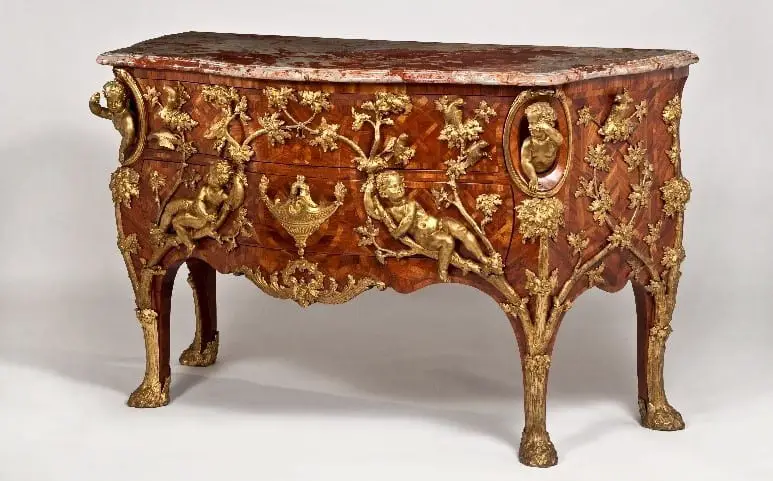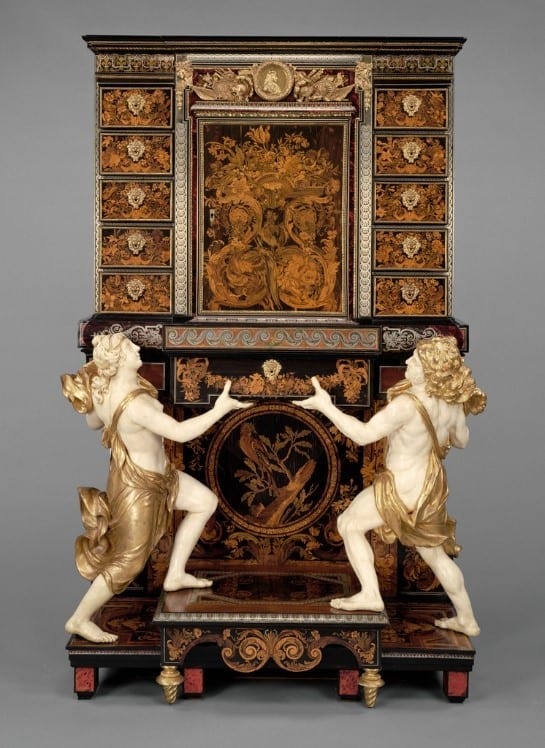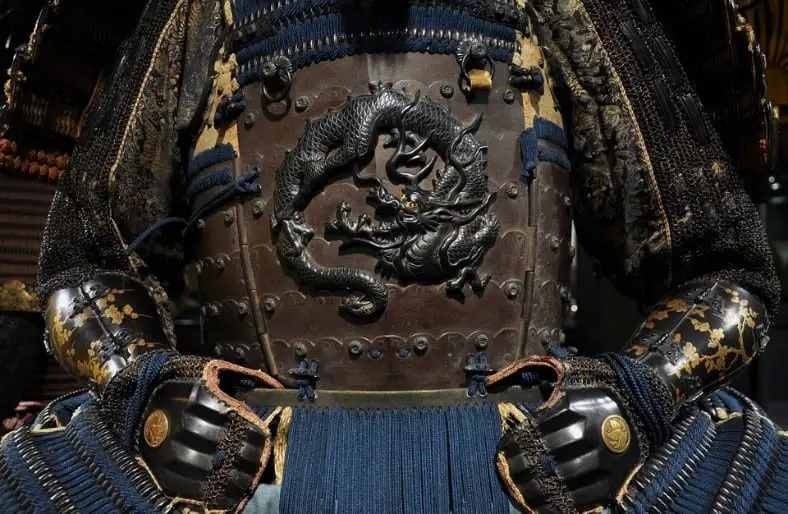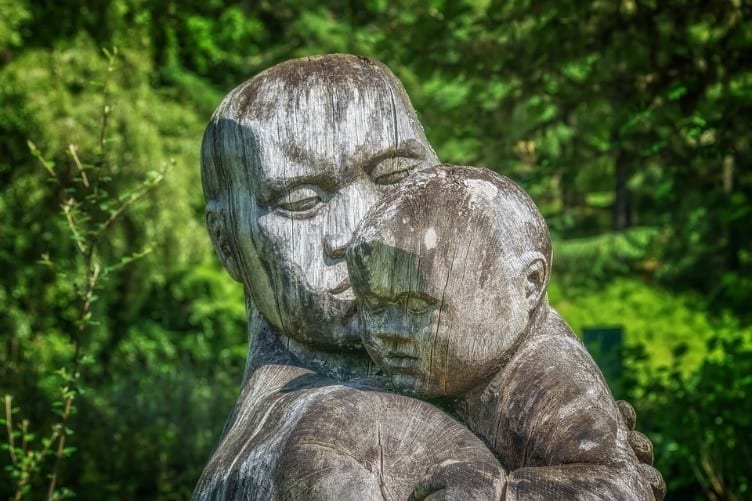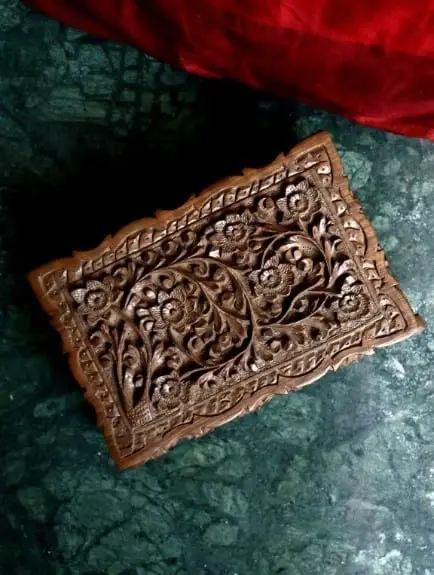
Originating from the second-most populous country in the world, the ingenious art of walnut wood carving in Kashmir, India has been widely recognized as a unique trademark of the region.
To be more specific, walnut wood carving is manufactured in the state of Jammu & Kashmir. Often denoted by the acronym J & K, the state is located in northern India.
In fact, a large part of the state’s territory covers the Himalayan Mountains that separate the Tibetan plateau from the plains of India.
There are three regions that make up the state of Jammu and Kashmir, namely the Kashmir Valley, Ladakh, and Jammu.
According to historians, walnut wood carving was first introduced in Kashmir in the 15th century.
Sheikh Hamza Makhdoom is considered the trailblazer of Kashmir walnut wood carving.
However, it was thanks to the king – Zainul Abdideen, who reigned the country during this particular period that walnut wood carving was promoted.
Above all, the king’s efforts for promoting the craft of walnut wood carving in Kashmir were targeted towards improving the economy of the Kashmir Valley.
Looking at the Earliest Examples of Kashmir Walnut Wood Carving & Understanding the Significance of the Ancient Craft to the Local Economy

Image Courtesy of pixabay.com
At first, the art of Kashmir walnut wood carving was restricted to the creation of royal palaces and houses.
The elaborate wood carvings that decorated the residences of the nobles were also introduced to shrines later on.
Up-to-date, there are several magnificent examples of ancient walnut wood carving in Kashmir.
Kashmir Walnut Wood Carving and Charar-e-Sharif Shrine
For instance, the shrine of Noor-ud-din-Wali at Charar-e-Sharif has turned into a notorious building marked by the elaborate walnut wood carvings in the region, being one of the earliest examples of the ancient craft.
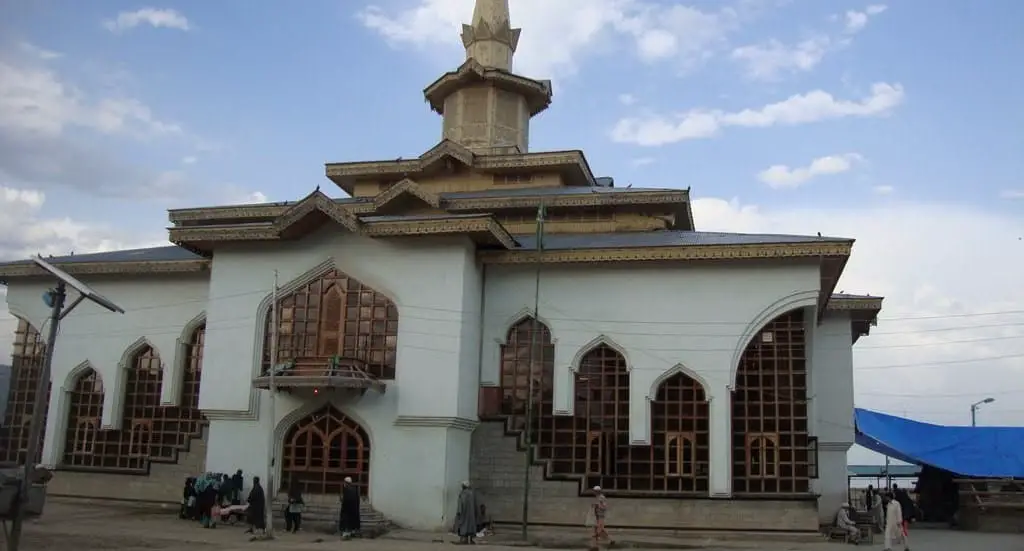
Charar-e-Sharif shrine – Image Source
Introducing the rich cultural heritage that dates back to over 600 years ago, the Charar-e-Shari Shrine is labeled as one of the most ancient shrines in India.
It was built to pay tribute to one of the holy saints of Sufism – Sheikh Noor-ud-din Noorani commonly referred to as Hazrat Sheikh Noor-ud-din-Wali.
The Charar-e-Sharif shrine is also proudly introduced among the 7 wonders of India.
Interestingly, Sheikh-Noor-ud-din Wali was also a great connoisseur and master of poetry and verses.
Should you have a friend,
Sacrifice yourself for him.
From time to time, a friend
Is breezy dawn!
Earth, earthly be, free from
Birth-Re-birth;
What need remains for
Protective defense?
Or
What need remains
To fear fate?
Certainly, there is no doubt that his love for art can also be found in the mesmerizing wood carvings of the legendary shrine built to denote him.
Sheikh-Noor-ud-din Noorani is said to have lived a very simple life, and only nine people gathered at the shrine after his death in 1438.
Most noteworthy, Sheikh-Noor-ud-din Noorani managed to live humbly but left an incredible trace in the history of walnut wood carving in Kashmir that keeps sparkling for centuries after he left this world.
Kashmir Walnut Wood Carving and the Naqshaband Mosque
Another emblematic building that showcases the mastery and beauty of walnut wood carving in Kashmir is the Naqshaband mosque.
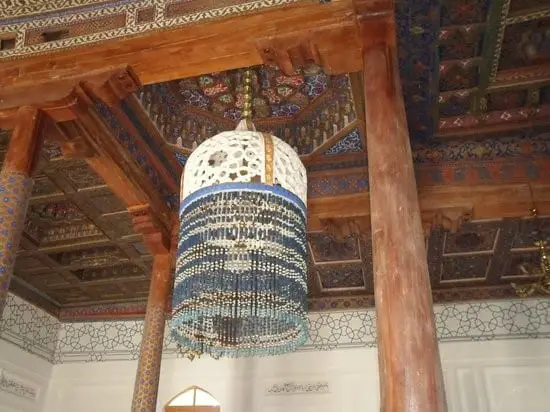
Elaborate woodcarvings on the ceilings of the beautifully decorated interior of the Nashqband Mosque – Image Source
But how come one of the most famous buildings related to the rich cultural heritage of India is a mosque? In short, Kashmir is the only state in India where the Muslim-majority population is dominant.
Interestingly, Islam is estimated as the fastest growing religions in India based on research stats from 2011.
However, keeping in mind that Hinduism makes up for about 15% of the religions’ share in the country, a stunning 77% of all people in India belong to religious schools different than those of Hinduism and Buddhism.

Image Courtesy of pixabay.com
But what do the religious beliefs of the people in India have to do with the art of walnut wood carving?
In a nutshell, the spiritual beliefs of the artisans who create the stunning Kashmir walnut wood carvings inevitably become apparent through their craft by the embedding of important symbols.
Unfortunately, the increasing number of tourists interested in experiencing the ancient religious heritage of India has also been affected by the poor travel safety described with the rise of scamming at touristy religious sites.
Video by Karl Rock – Scammed at Religious Places in India
Source: youtubec.om
While this disturbing practice may be still apparent, it is good to keep in mind that India’s population was ranked as one of the poorest in the world, with about 2/3 of the people living in poverty with a daily budget of approximately $2.

A young girl selling fruits on the roadsides of India – Image Courtesy of pixabay.com
However, during the last decades, India has managed to drastically decrease poverty rates, and crafts like that of Kashmir walnut wood carving are extremely important and beneficial to the local economy, and in return, are highly influential to the life of the locals.
Video by ANI News – Watch: Kashmir’s walnut wood furniture in demand – Jammu and Kashmir News
Source: youtube.com
Above all, the incredible diversity of different religions in the country lays the foundation of the future of walnut wood carving.
Even though it is highly specific to the region of Kashmir, the culture of walnut wood carving will keep developing throughout the next centuries, and we are surely about to witness the influence of various trends on the ancient craft of Kashmir walnut wood carving.
However, the major postulates of the incredible culture of walnut wood carving remain the same.
These postulates include the techniques for recognizing and working with the endemic species of Walnut trees in the region, the traditional motifs recreated by the master wood carvers, as well as the specific tools and carving styles that lasted throughout the centuries-long before Kashmir walnut wood carving earned world acknowledgment.
Digging into the Secrets of the Endemic Walnut Trees Used in the Ancient Craft of Kashmir Wood Carving

Juglans Regia is the scientific name that refers to the magnificent type of walnut trees that are native to the region of Kashmir.
Yes, it is thanks to the Juglans Regia tree species that one of the hallmarks of the country – Kashmir walnut wood carving, was born.
On another note, the walnut tree is locally known as “Doon Kul.”
As a matter of fact, there are four major varieties of walnut trees, namely “Vont Dun” (or “Wantu”) which refers to trees that give off fruit with a distinctly hard shell.
On the other hand, there are “Dunu” and “Kakazai” (or “Burzol”) walnut trees, known for bearing “the best fruit” that possess a very light shell.
Last but not least, the so-called “Khanak” walnut trees are not cultivated like Vont Dun, Dunu, and Kakazai varieties but are found to grow in the wild.
Most noteworthy, the walnut trees need to reach a certain maturity before they can get cut down for building and/or wood carving purposes.
Thus, Doon Kul trees need to be at least 300 years old before they are ready to be employed as part of the process of creating the spectacular Kashmir walnut wood carving designs.
Nonetheless, the different parts of the walnut trees differ in terms of being able to produce quality carvings.
For instance, the branches are known to possess a lighter color as compared to the color of the roots or the trunk of the tree. What’s more, the grain is barely noticeable.
Meanwhile, the color of the trunk is naturally darker than that of the branches.

However, the darkest and the most highly priced type of wood obtained from walnut trees in the Kashmir craft of carving is the timber that comes from the roots.
The grain of the roots is perfectly well-pronounced. But moreover, the dark parts of the walnut trees are said to be the strongest, resulting in increasing the durability of the carvings.
Hence, it almost goes without saying that wood from the roots is the most expensive as compared to wood from the other parts of the walnut tree.
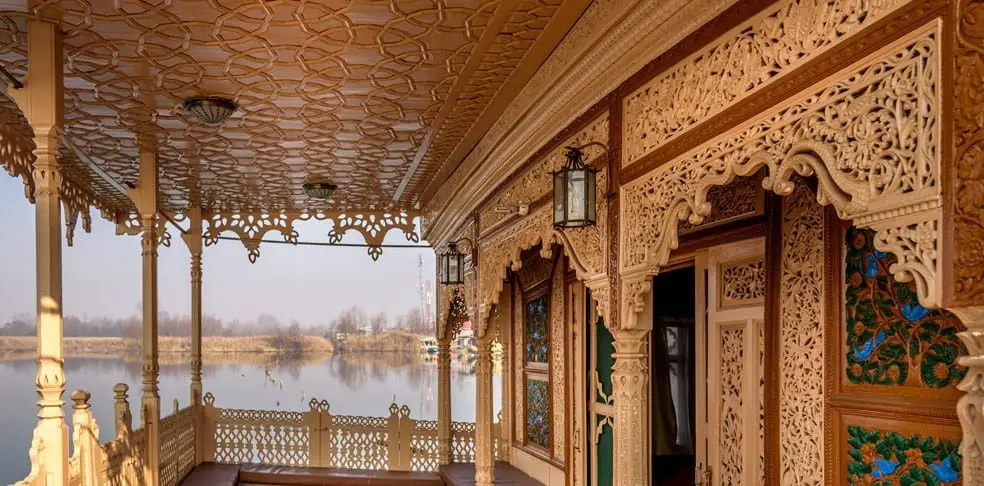
Kashmir houseboats have been growing in popularity. Then again, the trademark of the region – Kashmir walnut wood carvings are celebrated through the rich decorations of the contemporary houseboats – Image Source
Understanding the Importance of Seasoning Walnut Trees Used in the Craft of Kashmir Carving
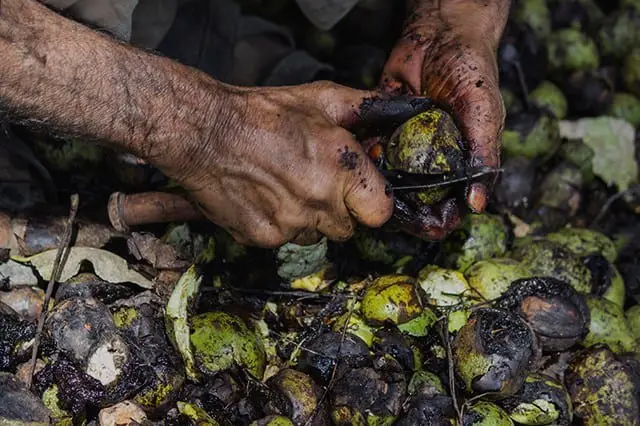
Harvesting walnuts are one of the crucial sectors of the local economy in Kashmir – Image Source
Not only are walnut trees expected to reach the age of at least 300 years before being suitable for carving. What’s more, the process of storing, seasoning, and prepping the wood for carving is also very strict.
For a start, all the planks need to be carefully piled. Prior to piling, though, the planks are first precisely numbered (or in other words, dated).
One extremely important aspect of storing walnut wood is the carrying out of the entire process of dating and piling only outside and always in shade.
On the one hand, the free flow of fresh air is mandatory to ensure the quality seasoning of the wood. On the other hand, the lack of contact with the sun relates to crucial tannins, and it also prevents the too abrupt evaporation of moisture.
Finally, seasoning proceeds for anything between one and four years before the process is fully and successfully accomplished.
Traditional Motifs and Tools Typical for Kashmir Walnut Wood Carving
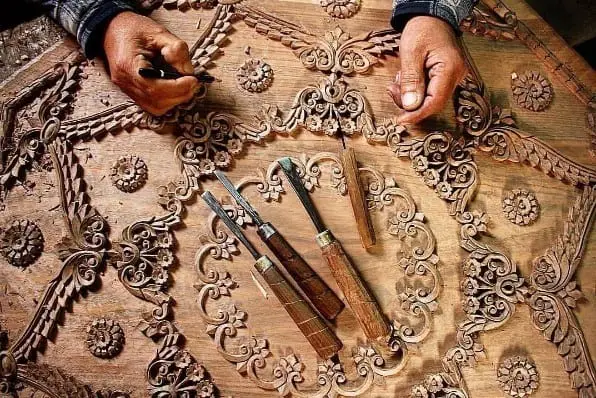
In India, the term for master carver is “naqqash.”
Before getting down to the process of carving, the master wood carver first needs to etch the very basic patterns straight onto the well-seasoned piece of wood.
Next, the naqqash uses his chisels and a mallet in order to remove away the unwanted parts so that the design emerges underneath.
Typically, carving of tiny items such as jewelry boxes, for example, requires the highest set of craftsmanship and skills since small details inevitably prove to be much more time-consuming.
However, decorating furniture is also an elaborate process, especially with the extreme eye for the detail needed to adorn an entire piece while also holistically representing a particular design in all its harmonious glory.
Video by Pearl FLBM – kasmiri walnut carvings final movie
Source. youtube.com
When it comes to the motifs that gracefully illuminate the Kashmir wood carving designs, the influence of different cultures and religions can be easily spotted.
Ultimately, some of the reoccurring motifs include lotus flowers, iris flowers, as well as roses. Flowers belong to the so-called Gul Tarah (Flower Motif) group that includes the depiction of various flowers that can either be represented separately or as a bouquet.
On the other hand, chinar leaves and grape vines, including bunches of grapes are also widely spread motifs in the art of Kashmir walnut wood carving. Dach Tarah (Grapes Motif) is considered the most popular in Kashmir wood carving along with Bohni Tarah (Chinar Motif).
Meanwhile, pears that grow in abundance in the country are among some of the most popular motifs, too.
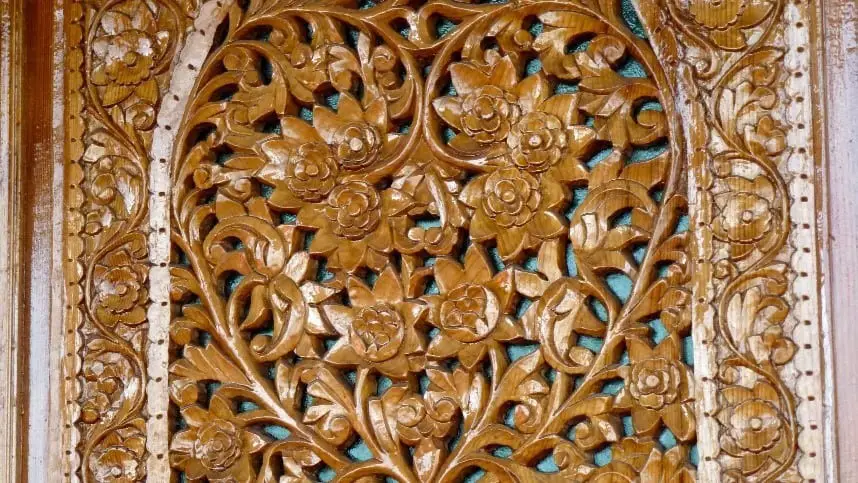
Other widely used motifs include Aghdar Dhar (Snake Motif), Jungle Tarah (referring to depicting various scenes from the surrounding landscapes), Janavar ti Jandhar Tarah (Animal and Animate Motif), and Badam Tarah (Almond Motif) that is inspired by the blossoming almonds in the region.
Depending on the intricacy of the patterns, masters of Kashmir walnut wood carving may spend an average of 2 days and up to 6 months to complete a single piece.
Once finished, the pieces are then carefully polished and a thin layer of wax or lacquer is applied. Interestingly, walnut wood comes with an inherent, distinct and smooth sheen that “peeks” through the applied finish, giving off a unique and magical charm.
The Incredible Culture of Walnut Wood Carving: The Takeaway
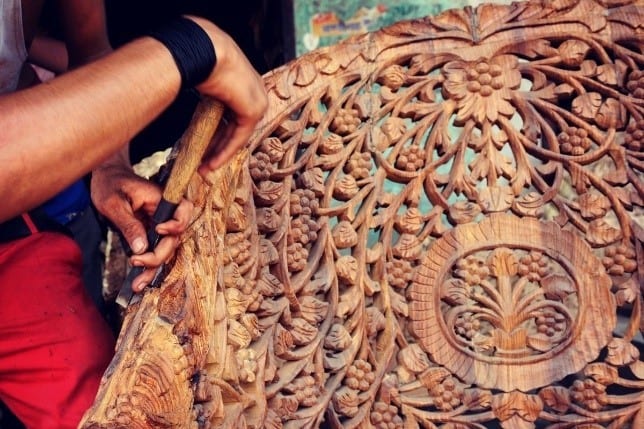
India is still often labeled as a country of contrasts.The gray colors of the dusty streets oppose the bright nuances of the traditional dresses of Indian women. The spicy, multicolored food, spices, and drinks appear opaque to the nearby buildings that may resemble abandoned ruins.
“Let the beauty of what you love be what you do”
Rumi
It is somewhere in the contrasts where the ancient craft of Kashmir walnut wood carving was born. Gradually, the ancient craft managed to travel through the centuries, carrying the wisdom and delicate beauty born by the hands of the gifted local artisans.


